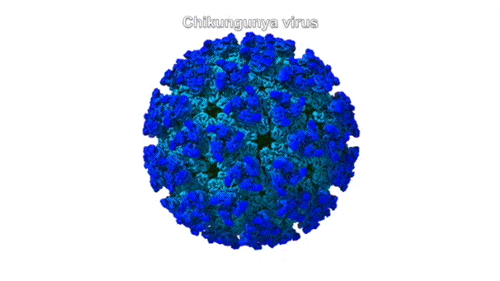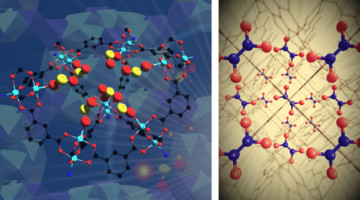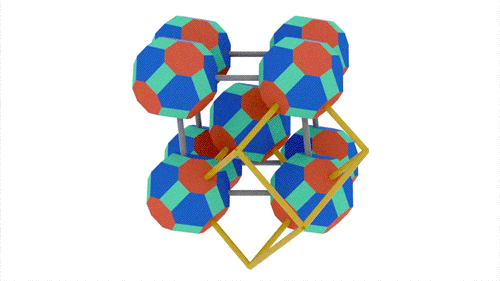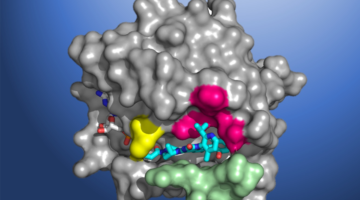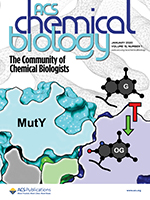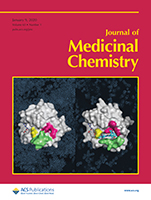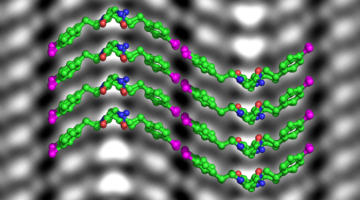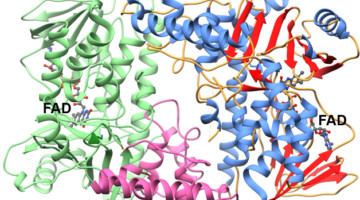Scientists have designed a biocompatible polymer that has the potential to advance photothermal therapy, a technique that deploys near-infrared light to combat antibacterial-resistant infections and cancer. The team synthesized the polymer by stringing together small molecules called ionic azaquinodimethanes, which they characterized at the ALS. Read more »
ALS Work Using Scattering/Diffraction
These techniques make use of the patterns of light produced when x-rays are deflected by the closely spaced lattice of atoms in solids and are commonly used to determine the structures of crystals and large molecules such as proteins.
Molecular Handle Enables Viral Attack on Joint Cells
A collaboration of university and industry researchers used x-ray crystallography to investigate how the chikungunya virus, which can cause debilitating joint pain, engages a receptor protein found on the surfaces of joint cells. The work provides a path forward in the fight against a family of viruses that can result in acute and chronic arthritis. Read more »![]()
![]()
Crystallography Reveals How New Molecular Cages Trap Toxic Gases
Current technologies for reducing toxic gas emissions are often ineffective and wasteful. Crystallographic analyses of two new MOF materials revealed how they reversibly bind their target gases, enabling the materials to be reused over many cycles (reducing waste) and permitting subsequent conversion of the gases into valuable chemical products. Read more »
The Choreography of Quantum Dot Fusion
X-ray scattering experiments helped reveal how nanosized crystals (“quantum dots”) self-assemble and fuse to form “supercrystals” with potentially useful electronic properties. The findings provide new insight into the fabrication of high-performance, low-cost electronic materials for photovoltaic and photon-sensing applications. Read more »![]()
![]()
Unique Cancer Drug Discovered With Help From Advanced Light Source Begins Historic Clinical Trial
Errors in the KRAS gene, which encodes a crucial cell-signaling protein, are one of the most common causes of cancer. Seeking to develop a long-sought direct inhibitor, researchers at Amgen conducted x-ray crystallography of KRAS(G12C) proteins at the ALS. The high-resolution structural maps helped Amgen make the breakthrough discovery of a small pocket on the molecule. Read more »
Structural Basis for Finding OG Lesions and Avoiding Undamaged G by the DNA Glycosylase MutY
Finding OG and avoiding G: DNA repair enzyme MutY distinguishes between undamaged guanine (green) and oxidized guanine when targeting OG:A mispairs. A structural motif within the C-terminal domain (violet) responds to OG to G substitution and appears mechanistically coupled to the adenine removal site (gray) in the N-terminal domain (cyan). Read more »
Discovery of a Covalent Inhibitor of KRASG12C (AMG 510) for the Treatment of Solid Tumors
KRASG12C has emerged as a promising target in the treatment of solid tumors; however, clinically viable inhibitors have yet to be identified. Here, researchers report on structure-based design and optimization efforts, culminating in the identification of AMG 510, a highly potent, selective, and well-tolerated KRASG12C inhibitor currently in phase I clinical trials (NCT03600883). Read more »
Freeze Frame: Scientists Capture Atomic-Scale Snapshots of Artificial Proteins
Protein-like molecules called polypeptoids have great promise as precision building blocks for creating a variety of designer nanomaterials. In this study, rsearchers used cryo-EM, a technique originally designed to image proteins in solution, as well as x-ray scattering techniques, to characterize the structure of polypeptide nanosheets. Read more »
Genetic Blueprint for the Bioproduction of an Antidepressant Drug Candidate
A set of genes from a marine bacterium has been found to encode the biosynthesis of a promising antidepressant drug candidate. This work, which used the ALS to solve the structure of a key enzyme, could enable industrial-scale bioproduction of the drug in ways that are more efficient and sustainable than chemical synthesis. Read more »
Argon: Not So Noble in Earth’s Core
Researchers demonstrated the synthesis of a thermodynamically stable compound of argon and nickel at temperatures and pressures representative of the Earth’s core. The ability of argon, a noble gas, to react with other elements under these conditions may help solve outstanding geological questions, including the “missing argon paradox.” Read more »![]()
- « Previous Page
- 1
- …
- 20
- 21
- 22
- 23
- 24
- …
- 39
- Next Page »

